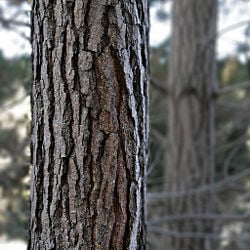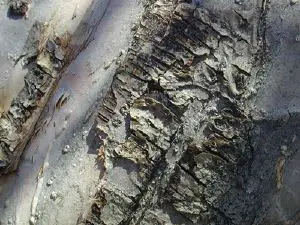Bark
For other meanings of bark, see Bark (disambiguation).
Bark is the outermost layer of stems and roots of woody plants such as trees. It overlays the wood and consists of three layers, the cork, the phloem, and the vascular cambium – in other words, most of the stem except for the xylem (this division may seem arbitrary, but the easiest way to split a stem parallel to its length is by pulling the bark away from the xylem). The bark of some trees is edible.
The vascular cambium is the only part of a woody stem where cell division occurs. It contains undifferentiated cells that divide rapidly to produce secondary xylem to the inside and secondary phloem to the outside.
Along with the xylem, the phloem is one of the two tissues inside a plant that are involved with fluid transport. The phloem transports organic molecules (particularly sugars) to wherever they are needed.
Cork, sometimes confused with bark in colloquial speech, is the outermost layer of a woody stem, derived from the cork cambium. It serves as protection against damage, parasites and diseases, as well as dehydration and extreme temperatures. Cork can contain antiseptics like tannins. Some cork is substantially thicker, providing further insulation and giving the bark a characteristic structure, in some cases thick enough to be harvestable as cork product without killing the tree.
Among the commercial products made from bark are cork, cinnamon, quinine (from the bark of Cinchona) and aspirin (from the bark of willow trees). The bark of some trees notably oak (Quercus robur) is a source of tannic acid, which is used in tanning.
See also
- Bark painting
- Bark beetle
- Barque (Bark ship)
- Trunk (botany)
Credits
New World Encyclopedia writers and editors rewrote and completed the Wikipedia article in accordance with New World Encyclopedia standards. This article abides by terms of the Creative Commons CC-by-sa 3.0 License (CC-by-sa), which may be used and disseminated with proper attribution. Credit is due under the terms of this license that can reference both the New World Encyclopedia contributors and the selfless volunteer contributors of the Wikimedia Foundation. To cite this article click here for a list of acceptable citing formats.The history of earlier contributions by wikipedians is accessible to researchers here:
The history of this article since it was imported to New World Encyclopedia:
Note: Some restrictions may apply to use of individual images which are separately licensed.


